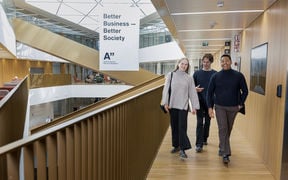Sustainable construction turned School of Business into pleasant, functional space

The School of Business building has been located in Otaniemi for five years. The new building was completed in December 2018 and the School of Business faculty and staff members moved to the premises in the following February. At the same time, Master of Science in Economics and Business Administration and related doctoral degree programmes also started in the new building. Bachelor-level education continues to be offered at the Undergraduate Centre, where courses have been running since autumn 2015.
The building is part of a larger complex, the other two are the School of Arts, Design and Architecture building called Väre and a shopping centre called A Bloc. The block has been designed by Verstas Arkkitehdit made up of Aalto's alumni, with Jussi Palva as their main designer.
The School of Business has been built in accordance with the requirements of the LEED environmental certificate (Leadership in Energy and Environmental Design). The classification is the world's most widely used global environmental classification system for buildings, which aims to reduce the environmental load during construction and use of buildings. The certification criteria include reducing energy consumption, efficient water use, reducing carbon dioxide emissions, improving indoor air quality and the location of the site.
Efficient collection of geothermal and solar electricity
Approximately 80 per cent of the heating and up to 95 per cent of the cooling of the School of Business building are produced with geothermal heat, also known as ground heat. A total of 74 geothermal wells have been dug under the building, reaching the depth of 300 metres. Geothermal heat is renewable solar energy stored in the soil, obtained from the bedrock and the surface layer of the soil. Supporting geothermal heat, district heating is used as a second form of heating. It is obtained from Fortum as a computationally zero-emission heat product Fortum Eko (in Finnish). With regard to cooling, the remaining bit is produced with electricity. Some of the lighting in the building uses LEDs with motion sensors.

There are 156 solar panels on the roof of the building and nearly 600 solar panels on the roof of Väre. The panels of the School of Business will produce 35 MWh of solar electricity per year and of Väre 140 MWh.
‘According to Vattenfall, the average electrical energy consumption of an electrically heated single-family house (120 m2) is approximately 18,500 kWh/year. Thus, the total amount of solar energy (175,000 kWh) at the School of Business and Väre could be used to manage the annual need for electricity in 9.5 single-family houses,’ explains Project Manager Perttu Kähäri, Professor of Practice at the Department of Management Studies of the School of Business.
Other environmentally friendly choices
In accordance with the LEED environmental certificate, the School of Business has also invested in indoor air quality, ergonomics and acoustics. The interior and construction materials are durable and non-toxic, chemicals have not been used for its cleaning, and furniture textiles are approved by the Finnish Allergy, Skin and Asthma Federation.
The location of the building is very central on the Otaniemi campus. The distance to the Aalto University metro station is only 100 metres. When the light rail started operating in October 2023, public transport connections improved further. The light rail is a central line for transverse traffic in the Helsinki Metropolitan Area, connecting the traffic nodes in the area with its 25-kilometre-long route from Keilaniemi in Espoo to Itäkeskus. There are 34 stops along the light rail line.
‘The School of Business also encourages active commuting, and there is a spacious locked storage on the street level for storing bicycles, for example. There are also plenty of other frame-locking bicycle racks on the campus,’ says Perttu Kähäri.
School of Business
We strive for better business and better society. We excel in education and research with a multidisciplinary approach and in collaboration with our partners.

Read more news

Call for applications: Aalto Creatives pre-incubator programme starts in March 2025
The application period for the Aalto Creatives pre-incubator programme is open until 10.2.2025
The City of Espoo and Aalto University signed a strategic agreement for a new five-year partnership period
The collaboration includes investments in the Otaniemi area, business and innovation activities, and efforts to integrate international talent.Talent Boost Strategy Project at Aalto in 2021-2024
This article takes a look at the achievements of the Talent Boost project at Aalto.